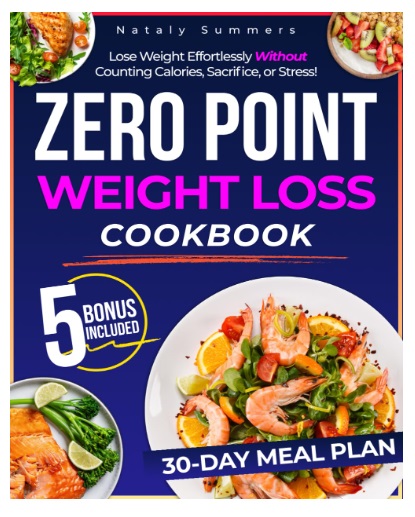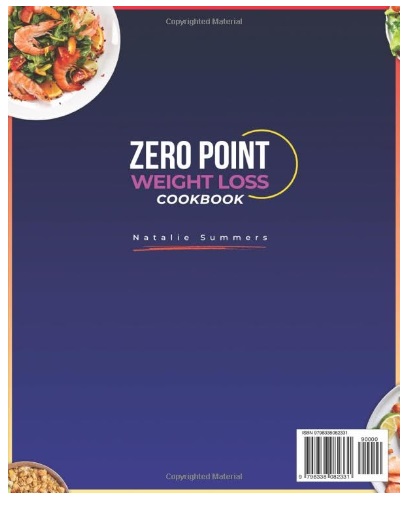
Zero Point Weight Loss Cookbook review
Click Picture and Video & Price & More
Introduction of Zero Point Weight Loss Cookbook review
The Zero Point Weight Loss Cookbook has generated buzz among individuals seeking sustainable weight loss strategies. Unlike traditional diet books that often focus on calorie counting or restrictive eating, this cookbook offers a fresh perspective by highlighting the concept of “zero-point” foods. For those familiar with programs like Weight Watchers, the term may sound familiar. However, this cookbook aims to go beyond the basics by introducing readers to creative ways of utilizing these foods to build a healthy, flavorful, and satisfying diet.
In this review, we will explore the key features, benefits, limitations, and usability of the cookbook, ultimately helping you determine whether it’s a good fit for your weight-loss journey.

Click Picture and Video & Price & More
Key Features of Zero Point Weight Loss Cookbook review
To begin with, the Zero Point Weight Loss Cookbook revolves around the principle that not all foods are created equal. It emphasizes the use of nutrient-dense, low-calorie foods that can be eaten freely without the guilt of overconsumption. Vegetables, fruits, lean proteins, and legumes form the backbone of many of the recipes. Moreover, the book offers a variety of meal options—ranging from breakfasts and snacks to full-course dinners.
Another unique feature is the inclusion of diverse cuisines. Recipes inspired by Mediterranean, Asian, and Latin American flavors add variety to what could otherwise be considered typical “diet” meals. Additionally, each recipe comes with detailed nutritional information, which is particularly useful for individuals who want to track their macro intake.
Strengths and Benefits of Zero Point Weight Loss Cookbook review
First and foremost, one of the most significant advantages of the cookbook is its accessibility. Because zero-point foods are often basic ingredients like eggs, spinach, or chicken breast, they are readily available in most grocery stores. As a result, preparing these recipes does not require specialized or expensive ingredients.
Furthermore, the cookbook promotes sustainable weight loss. Instead of imposing restrictions, it encourages readers to enjoy wholesome, filling meals that align with long-term lifestyle changes. For example, dishes like zucchini noodles with marinara sauce or fruit salads with yogurt toppings demonstrate how healthy meals can be both satisfying and easy to make.
Additionally, the book fosters a positive mindset around food. Rather than labeling items as “forbidden” or “cheat foods,” it emphasizes balance. Readers can indulge in higher-calorie foods occasionally while relying on zero-point foods to stabilize their eating patterns throughout the week.
Areas for Improvement
However, the Zero Point Weight Loss Cookbook is not without limitations. Although the concept of zero-point foods is appealing, it may not resonate with everyone. Some users might feel overwhelmed by the need to switch from processed foods to a more whole-food-based diet. In addition, individuals looking for desserts or comfort foods might find the cookbook’s focus on health-conscious recipes somewhat limiting.
Another potential drawback is that it assumes a degree of familiarity with cooking techniques. Beginners might struggle with some of the more intricate recipes, especially if they lack experience in meal prepping or handling fresh ingredients. Moreover, while the book promotes variety, certain recipes may require multiple ingredients, which could pose challenges for people with busy schedules.
Usability and Layout
From a usability standpoint, the Zero Point Weight Loss Cookbook excels in clarity and organization. The layout is reader-friendly, with each section divided by meal type (e.g., breakfast, lunch, dinner, and snacks). Additionally, the book offers useful cooking tips and substitutions, ensuring that readers can modify recipes to suit their personal preferences or dietary restrictions.
Moreover, the presence of vibrant, high-quality images enhances the reading experience. The photos not only make the dishes look appetizing but also provide visual guidance for readers attempting new recipes. Furthermore, the cookbook includes portion suggestions, making it easier to manage serving sizes for different dietary goals.
Conclusion
In summary, the Zero Point Weight Loss Cookbook offers a practical and creative approach to weight loss through the use of zero-point foods. Its emphasis on variety, accessibility, and sustainability makes it a valuable resource for anyone looking to build healthier eating habits. While it may not cater perfectly to everyone—especially those seeking indulgent or convenience-based meals—it still provides a solid foundation for weight management.
If you are someone who enjoys experimenting in the kitchen and values long-term health over quick fixes, this cookbook could be an excellent addition to your collection. However, for individuals who prefer pre-packaged solutions or need simpler meal options, it may take some time to adjust to the lifestyle promoted within these pages.
All things considered, the Zero Point Weight Loss Cookbook stands out as a guide that not only educates readers on healthy eating but also empowers them to make informed dietary choices for life.
More review: Healthy by Design